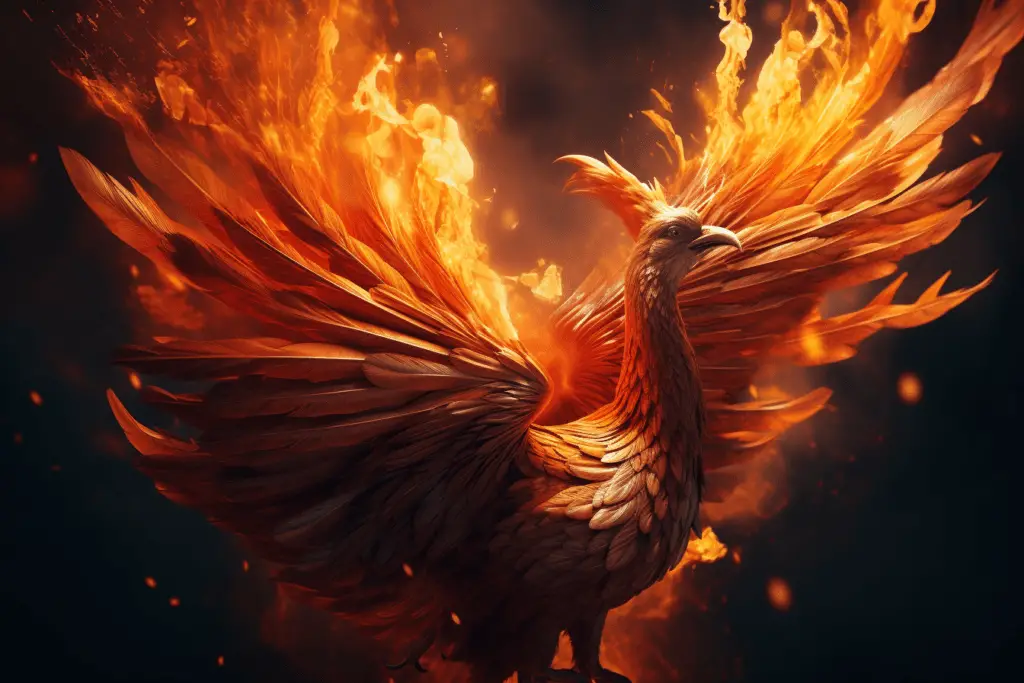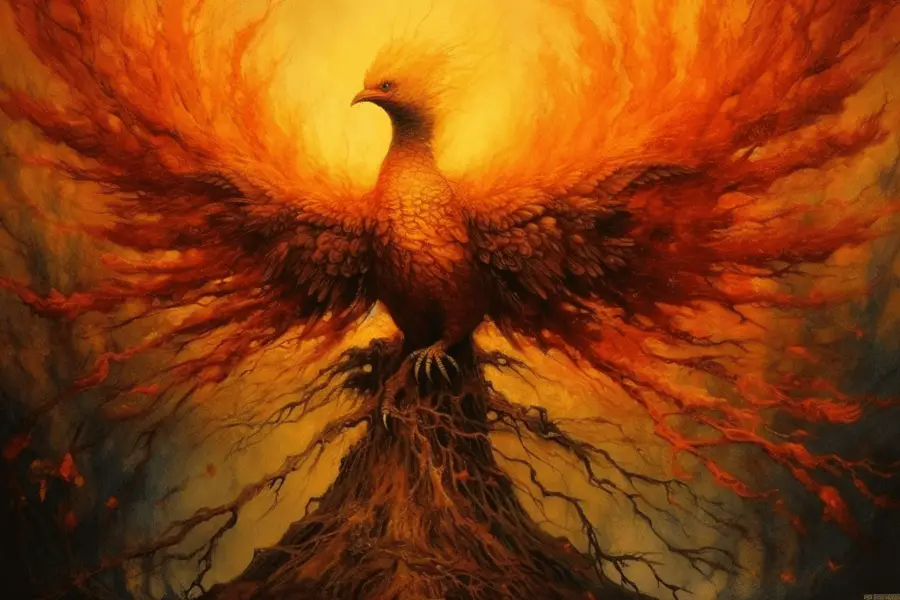Share the Lore!
By: Sid Meyers
From Ashes to Glory: The Mythical Power of the Phoenix
What do you get when you cross a bird with the power of rebirth? The answer: the phoenix. This mythical creature has captured the imaginations of people across cultures for centuries. But where did the phoenix come from, and what does it symbolize?
Origins of the Phoenix in Mythology
The phoenix’s origins are rooted in ancient mythology, with different versions of the creature appearing in various cultures. In ancient Egypt, the Bennu bird was seen as a symbol of the sun, creation, and rebirth. The Bennu was believed to have been born from the ashes of the god Osiris and was closely associated with the sun god Ra. It was said to have perched on the sacred ben-ben stone in the temple of Ra in Heliopolis.
In ancient Greece, the phoenix was a legendary bird that was said to have been born from the gods. According to Greek mythology, the phoenix had the ability to regenerate itself from its own ashes. It was also associated with the sun and the element of fire, with its feathers said to be made of flames.

The Romans also had their own version of the phoenix, which they described as a “marvelous bird.” Like in Greek mythology, the Roman phoenix was associated with the sun, fire, and rebirth. It was said to have lived for hundreds of years before burning itself to ashes and being reborn from them.
It’s clear that the phoenix has captured the imaginations of people across different cultures and time periods.
Fun Fact: In some versions of the myth, the phoenix is said to have a beautiful singing voice that can enchant anyone who hears it. In some versions of the myth, the phoenix was believed to sing a mournful song as it approached the end of its life, signaling its impending death and rebirth. The song was said to be so hauntingly beautiful that it would draw the attention of all creatures nearby.
Symbolism of the Phoenix in Mythology
So, what does the phoenix symbolize? At its core, the phoenix represents the power of rebirth and renewal. Its ability to rise from the ashes of its own destruction has made it a symbol of resilience, regeneration, and immortality.
In ancient Egyptian mythology, the Bennu bird was seen as a symbol of rebirth and creation. It was believed to have played a role in the creation of the world and was closely associated with the god of creation, Atum. The Bennu was also associated with the flooding of the Nile River, which was seen as a source of renewal and rebirth.
In Greek mythology, the phoenix was also associated with the power of rebirth and renewal. The story goes that the phoenix would live for hundreds of years before igniting itself in flames, only to rise again from its own ashes. This cycle of death and rebirth made the phoenix a symbol of immortality and eternal life.
The Romans also saw the phoenix as a symbol of rebirth and renewal. It was said to live for hundreds of years before bursting into flames and being reborn from its own ashes. The phoenix’s association with fire also made it a symbol of transformation and change.
In Chinese mythology, the Fenghuang is associated with the balance of yin and yang and represents the harmony between different forces. It is often depicted with a male counterpart, the dragon, and together they represent the union of masculine and feminine energies.
The Fenghuang is associated with good luck, prosperity, and the union of yin and yang. Unlike the Western versions of the phoenix, the Fenghuang is often depicted as a composite of different animals, including the body of a pheasant, the head of a crane, and the tail of a peacock.
In Christianity, the phoenix was seen as a symbol of resurrection and eternal life, and it was often depicted in early Christian art. The phoenix’s ability to rise from the ashes was seen as a metaphor for the resurrection of Jesus Christ.
In medieval Europe, the phoenix was often associated with alchemy and was seen as a symbol of transformation and spiritual rebirth. Alchemists believed that the phoenix’s ability to turn base metals into gold was a metaphor for their own attempts to transform themselves and achieve spiritual enlightenment.

Overall, the phoenix’s symbolism is a testament to the power of transformation and the human desire for renewal and rebirth. Its story has resonated with people for centuries and continues to be a symbol of hope and resilience in the face of adversity.
Fun Fact: The phoenix is often depicted with brilliant, colorful plumage, and in some myths, its feathers are said to possess healing properties. In many depictions of the phoenix, it is portrayed as having bright, vivid feathers that are said to symbolize the vibrant colors of the sun. According to some myths, the feathers of the phoenix are imbued with magical properties, such as the ability to heal and restore life.
Phoenix in Literature and Pop Culture
The phoenix has inspired many authors and filmmakers to incorporate this mythical bird into their works of art. From Harry Potter’s Fawkes to T.H. White’s The Once and Future King, the phoenix has made a significant impact on literature.
In J.K. Rowling’s Harry Potter and the Chamber of Secrets, Harry is saved from the venomous bite of the basilisk by the tears of Fawkes, Dumbledore’s phoenix. Fawkes is a symbol of hope and renewal in the series and serves as a guide for Harry throughout his journey.
The phoenix also makes an appearance in T.H. White’s The Once and Future King, where it represents the cyclical nature of life. The bird’s ability to rise from its own ashes serves as a metaphor for rebirth and the idea that life is a cycle of death and rebirth.
The phoenix has also become a popular symbol in pop culture. In the X-Men comic books and movies, the character Jean Grey has an alter-ego known as the Phoenix. She possesses the powers of a cosmic force that embodies life and destruction, which often causes chaos and devastation.
The phoenix has also made its way into music, with the British band Fall Out Boy’s song “The Phoenix” becoming a hit in 2013. The song’s lyrics touch on themes of rising from the ashes, overcoming obstacles, and never giving up.
In conclusion, the phoenix has become a symbol of hope, rebirth, and renewal across various cultures and mediums. Its appearance in literature and pop culture continues to inspire people to rise from the ashes of their own setbacks and strive for greatness.

Fun Fact: According to some legends, the phoenix is so powerful that its tears can heal any wound, and its blood can grant immortality to those who drink it. Similarly, in other cultures, the phoenix is believed to have healing powers that extend beyond the physical realm. For example, in Native American mythology, the phoenix is associated with spiritual rebirth and transformation, and its feathers are sometimes used in spiritual ceremonies to symbolize the process of spiritual awakening and growth.
Conclusion
The phoenix has been a symbol of renewal and rebirth throughout history, spanning across different cultures and religions. From ancient Egyptian and Greek mythology to modern-day pop culture, the phoenix continues to capture the imaginations of people all over the world.
As we have seen, the phoenix is a powerful symbol of transformation and renewal. Its ability to rise from the ashes and start anew has made it a symbol of hope for people throughout history. The phoenix reminds us that even in the darkest of times, there is always the possibility of new beginnings.
According to an article by National Geographic, the phoenix’s enduring appeal lies in its ability to resonate with people across different cultures and religions. The article notes that the phoenix represents the idea that death is not the end, but rather the beginning of a new cycle of life.
Additionally, in her book “Mythology: Timeless Tales of Gods and Heroes,” Edith Hamilton writes that the phoenix represents the idea that “nothing truly perishes but only changes form.” The phoenix’s transformation from ashes to a new life symbolizes the cyclical nature of life and death.
In conclusion, the phoenix is a powerful and enduring symbol of hope and renewal. Its story has captured the imaginations of people for thousands of years, and its legacy continues to inspire us to rise from the ashes and start anew.
